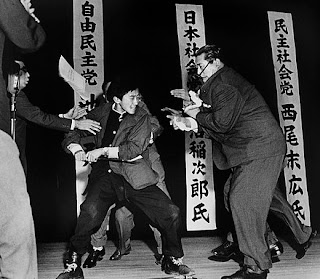Welcome back viewers
This month's Iconic Image is...
The Tokyo Stabbing
Intro
This photograph was taken on October 12, 1960, in Tokyo, Japan. It shows a young man about to stab a middle aged man with a short sword. Security guards are struggling to reach him before he can deliver a fatal blow to his target. This photograph (along with the video footage of the incident) would send shockwaves the world and come to show the impact of the Cold War on the country of Japan.
Part I
In the month of October 1960, all eyes of the people of Japan were glued to their television sets. They were ready to watch a televised election debate between three political party leaders in Tokyo's Hibiya Public Hall. The three leaders were: Suehiro Nishio of the Democratic Socialist Party, recently elected Prime Minister Hayato Ikeda of the Liberal Democratic Party, and Inejirō Asanuma of the Japan Socialist Party. The debate was attended by an audience of more than 2,500 people in the hall.
For many citizens in Japan, Inejirō Asanuma was a surprising addition to the debate. Asanuma was a known advocate for forceful socialism in Japan. He had been a strong supporter of Japan's entry into World War II and had gained national infamy due to his support for the Communist party of China. In the process of his activism, Asanuma had also made many enemies. Some of whom were willing to take drastic measures to silence him. One of them was a young student named, Otoya Yamaguchi.
Otoya Yamaguchi was born in Tokyo during World War II. Starting from his early childhood, Yamaguchi had grown up reading newspapers and had become a strong supporter of nationalism. Highly influenced by the rhetoric of Bin Akao (a Japanese nationalist), Yamaguchi was also fanatically anti-communist. And he was determined to fight it in any way that he could. His opportunity came on October 12, 1960, when he learned of the debate at Hibiya Public Hall.
Part II
The debate began after 2 PM in the afternoon. The first man to speak was Nishio. When he was finished, Asanuma walked up to the microphone and began his opening speech. Before he could get through his first sentence however, Asanuma's voice was drowned out by numerous right-wing audience members who began to heckle him. The heckling was so loud that reporters in the front row could not hear him. Five minutes later, the NHK moderator finally calmed the crowd and Asanuma resumed his speech. But at that moment, Otoya Yamaguchi (who had sneaked to the left of the stage while most of the attention was on the hecklers), rushed the stage.
Armed with wakizashi (a short samurai sword), Yamaguchi stabbed Asanuma in the left side while running at a full sprint. He then attempted to stab Asanuma second time but was grabbed by security guards. As he was dragged away, Yamaguchi was seen laughing at what he had done. At first Asanuma seemed unhurt (there was no blood visible on his shirt). However, within seconds of Yamaguchi's apprehension, Asanuma sank to his knees and collapsed. He was quickly carried off the stage and loaded into an ambulance.
The whole event had been photographed and videotaped by numerous reporters and journalists. One of them was the photographer, Yasushi Nagao. At the time, Nagao was working for the Mainichi Shimbun newspaper. When he noticed, Yamaguchi charging the stage, he quickly changed the focus of his camera from fifteen feet to ten feet. After Yamaguchi's first strike on Asanuma, Nagao snapped a photograph as the former attempted a second strike on the latter. He managed to capture the exact moment before Yamaguchi was tackled by security guards.
Epilogue
As Yamaguchi was taken into custody, Asanuma was rushed to the hospital. Unfortunately, his aorta had been severed after he was stabbed. By the time he arrived, Asanuma was dead. Otoya Yamaguchi was charged with first degree murder. However, he would never be brought to trial. Less than three weeks after the stabbing, Yamaguchi was discovered hanging from bedsheets within his prison cell. On the wall; written in toothpaste was the message, "Long live the Emperor". Throughout his incarceration, Yamaguchi was unrepentant for his actions.
Both men quickly became martyrs for their causes. Right-wing groups across Japan all mourned Yamaguchi and declared him an anti-socialist hero. Asanuma on the other hand, was memorialized by Prime Minister Ikeda as a patriot of Japan. Even though they had many differences, Ikeda called Asanuma, "a man who truly loved his country". Japan's Socialist Party declined over the next 30 years. It ceased to exist in the year 1996.
For his photograph of the assassination of Inejiro Asanuma, Yasushi Nagao received the 1961 Pulitzer Prize for photography and the World Press Photo of the Year. His photograph remains an iconic symbol of political violence and how it affects each country's next generation. It is one that definitely deserves its place in the history of photography.
https://rarehistoricalphotos.com/yamaguchi-assassinates-asanuma-1960/
https://www.theguardian.com/world/2016/oct/13/inejiro-asanuma-japan-politician-assassinated-1960
https://allthatsinteresting.com/inejiro-asanuma-assassination
https://web.archive.org/web/20090505150214/http://mdn.mainichi.jp/mdnnews/news/20090504p2a00m0na010000c.html
